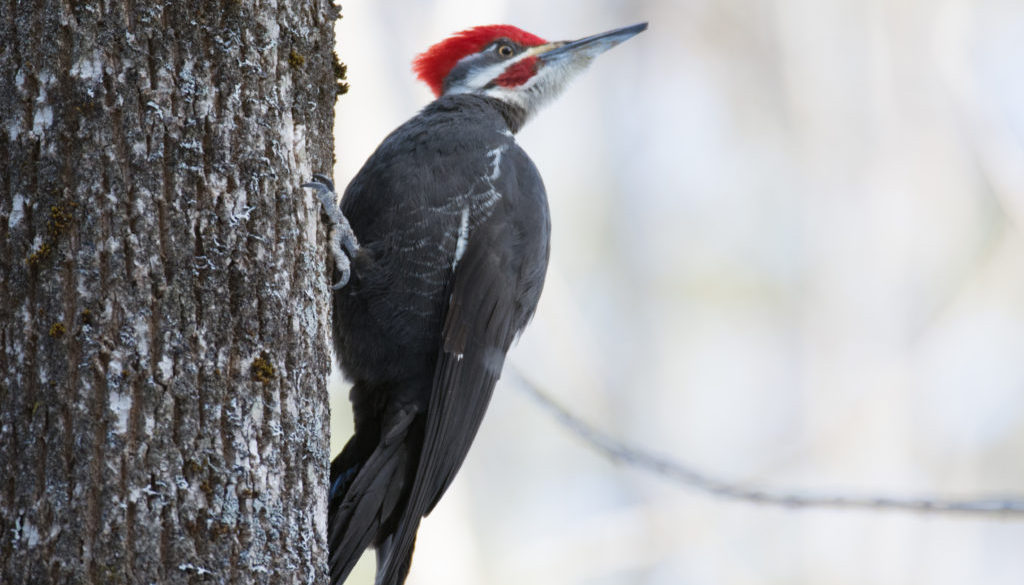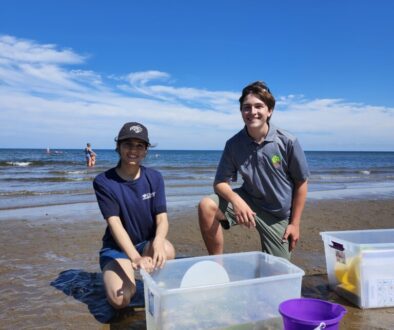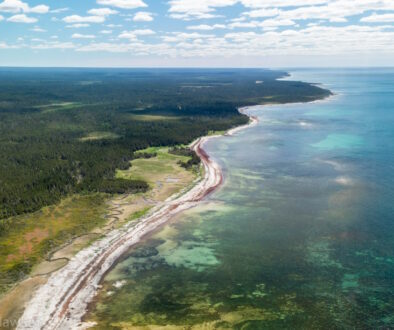10 Birds to spot this winter
When we think of winter, we see a crisp white landscape, fur boughs heavy with snow. We smell that fresh wintery smell and cozy wood fireplaces. We taste fresh snowflakes. But what do we hear? Maybe a deep and peaceful quiet—but maybe something more? From December to February, New Brunswick wilderness comes to life with the songs of chattering birds, the prying eyes of birds of prey, and the mysterious movements of owls. When you’re out in nature this winter, keep your eyes and ears peeled for a sighting of one of these ten birds that tough out the cold season with us.
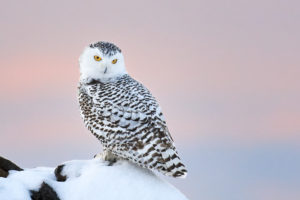
1. Snowy owl – A list of winter birds hardly seems complete without this special species. Perfectly camouflaged for the arctic tundra, the snowy owl is a winter visitor to New Brunswick that prefers wide-open spaces with few trees and high vantage points, like telephone poles. Snowy owls can sit in one place for hours, watching and waiting with their big yellow eyes to spot prey, like voles and other small rodents.
2. Black-capped chickadees – A well-known friend and the provincial bird of New Brunswick, the black-capped chickadee make our backyards a little brighter with their cheerful chickadee-dee-dee calls. Listen carefully, the more dee notes in their calls means they are feeling threatened! This tiny bird likes to collect food, hiding thousands of seeds and other foods in different places and remembering their locations later.
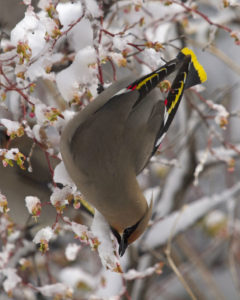
3. Bohemian waxwing – This regal-looking bird is a bit unpredictable, but if you have a winter-fruiting tree or shrub in your yard or on your favourite trail, you might spot a large flock of bohemian waxwings! These birds are expert fruit-finders, and sometimes travel long distances in big groups in search of berries. You might see this species flocking together with its familiar cousin, the cedar waxwing, so look for the distinct yellow patches in their tail feathers.
4. Snow bunting – Catch a bustling flock of these little black-and-white birds, who are more restless than us in winter, hopping place to place as fast as every ten minutes! Males have mostly white bellies, with rust-coloured patches on the head, and a dark and streaky back. Females have a rusty wash over their face, heads, and breasts and the same dark and streaky backs. You can spot snow buntings in open fields, croplands, shorelines, and roadsides.
5. King eider – If you’re near the ocean in New Brunswick, you might be lucky enough to see a flock of king eiders along the rocky coast. Sometimes king eiders flock among their cousins, the common eider, so look carefully for the male’s orange bill compared to the common eiders greyish-green bill in winter. King eiders are diving birds, so you might spot them ducking below the surface to grab a snack.

6. Ring-necked pheasant – A year-round resident of southern New Brunswick, the ring-necked pheasant, with its dark colours, will stand out as it scurries across the snowy white landscape. Like us in the depths of winter, this bird will remain dormant and inactive for days at a time when a cold snap hits! Ring-necked pheasants are common on agricultural lands and in grassy or brushy areas, so have a look for the bright greens, reds, and golds of the male and their unique long, pointed tail.
7. Rough-legged hawk – Another bird that summers in the arctic tundra, the winter is the best time to see the rough-legged hawk in New Brunswick. Usually this bird of prey can be sighted from a high vantage point, like poles, or hovering above wetlands or open spaces in search of small rodents. The rough-legged hawk comes in light-coloured and dark-coloured varieties, being highly mottled or a deep chocolate-brown. Look closely for their unique legs that are feathered all the way to their toes!
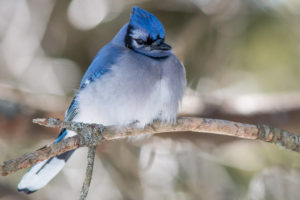
8. Blue jay – Another bright spot of winter, the blue jay is a familiar bird in New Brunswick backyards. In winter, blue jays are more likely to be found in flocks than in summer, when they tend to live in breeding pairs, though these pairs stay together within larger flocks! These winter flocks have a “pecking order” in which higher ranking individuals get the first chance to eat, choosing nuts, seeds, and fruits in winter.
9. Northern shrike – About the size of an American robin, the northern shrike is a predatory songbird, hunting insects, small mammals like rodents, and other birds. The adult bird has a grey head and black mask over the eyes with a thick, hooked bill for capturing prey. In late winter, listen for the males singing complex songs of harsh notes, chatters, trills, and whistles and the aak-aak-beek call.
10. Pileated woodpecker – Another year-round New Brunswick resident, the pileated woodpecker shines in winter with its deep black body, bright white face, and eye-catching red crest. A pair of pileated woodpeckers stay together in one territory all year, defending the area in the summer, but being more welcome to newcomer birds in the winter. Look for dead and dying trees where this bird might frequent for food or nesting.
While many of our wildlife friends leave us for the winter, hibernating or migrating to avoid the snowy weather, there are many birds that stick with us through the season! Take some time to get out into nature before spring returns and remember to look and listen for the birds of winter. Visit one of our year-round parks, including Mactaquac Provincial Park, Mount Carleton Provincial Park, or Sugarloaf Provincial Park, to enjoy more of winter in New Brunswick!
Give the gift of nature! Support the work of CPAWS-NB in protecting New Brunswick’s wilderness.
Header photo of pileated woodpecker by Justin Dutcher, Dutch Elms Studios

Julie Reimer is a PhD student at the Memorial University of Newfoundland and a Board Member of CPAWS-NB. Having worked in the whale watching industry in New Brunswick and conducted her Master’s research on conservation planning for the North Atlantic right whale, Julie is an advocate for MPAs in New Brunswick. Julie’s current research attempts to see the “bigger picture” of conservation, reaching beyond protected areas to understand the synergies between conservation actions and ocean industries. To connect with Julie, visit http://juliereimer.wixsite.com/hello.

